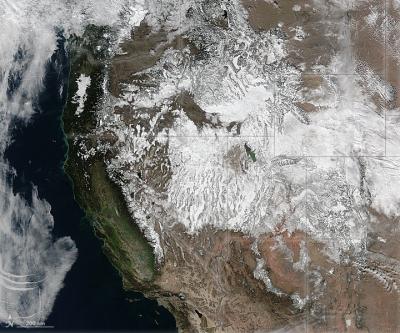Contrasting Responses of Mountain Snowpack to Warmer Sea Surfaces
Snowpack and precipitation are critical components of the western U.S. coastal mountain water cycles. Tropical Pacific Ocean sea surface temperature (SST) strongly influences snowpack in the western U.S. through atmospheric teleconnection, but scientists have a limited understanding of local SST effects. Research revealed that warmer, local SST enhances evaporation and heat flux from the ocean surface. The increased quantity and temperature of precipitation led to stronger snowmelt in the Cascade range but enhanced snowfall in the higher mountain elevations of the Sierra Nevadas. Local SST may provide useful data for predicting the snowpack in U.S. West Coast mountains.
Mountain snowpack is a primary source of summer runoff in the western U.S. Diverse meteorological factors, such as the amount and phase of precipitation and temperature, control the winter snowpack. Understanding how local SST influences mountain snowpack may improve predictions of winter snowpack and summer runoff—important supports to a host of regional human activities. The study also developed machine learning models that helped identify temperature-weighted precipitation as a key predictor of winter snowpack in the coastal mountains, which can be applied to predict snowpack relevant to hydrologic applications.
Researchers analyzed the response of mountain snowpack to different local SSTs along the U.S. West Coast. They conducted two regional climate simulations of the western U.S. and the northeastern Pacific Ocean during 2002 – 2015. These simulations utilized the same input, differing only in local SST conditions. Warmer local SST conditions reduced winter snow accumulation in the Pacific Northwest’s Cascade range and enhanced accumulation in California’s Sierra Nevada mountains.
To understand the dipole pattern of snowpack response, the researchers developed neural network-based machine learning models of snowpack at seasonal and monthly scales. These models skillfully predicted the snowpack responses simulated by the physics-based regional climate simulations, explaining over 95% of the spatial-temporal snowpack variations. Controlled experiments using the machine learning models revealed that the magnitude and temperature of precipitation are central to the divergent snowpack responses of the northern and southern mountain ranges. These findings reveal the important role local SST plays in modulating mountainous snowpacks, with significant implications for summer water resource availability in the snowfed region.

